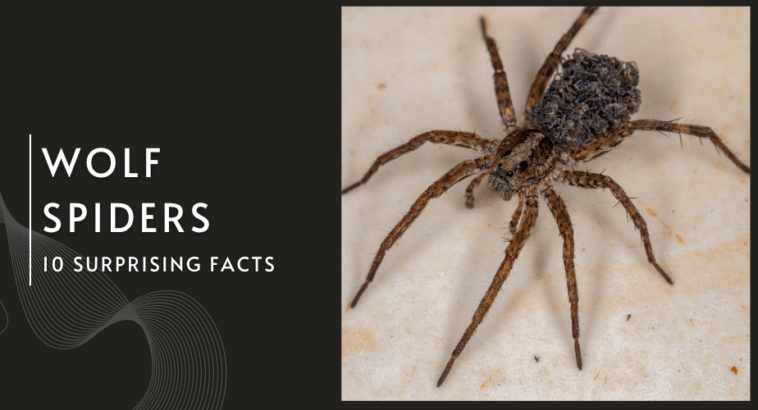The wolf spider is a fascinating member of the arachnid family, renowned for its powerful hunting skills and unique appearance. Unlike many of their web-spinning cousins, wolf spiders stalk and pounce on their prey, displaying incredible agility and keen senses. Found across various continents and habitats, wolf spiders have adapted to thrive from grassy meadows to rocky deserts. Recognizable by their robust build and often mottled brown or gray coloration, the wolf spider is more than just another garden creature; it is a key player in natural pest control and a marvel of evolutionary adaptation.
As nocturnal hunters, wolf spider bite play an essential role in ecosystems by preying on insects and other small invertebrates. This behavior not only highlights their unique predatory skills but also makes them vital allies to gardeners and farmers worldwide. With a broad distribution and remarkable resilience, the wolf spider continues to intrigue researchers and nature enthusiasts alike.
The Stalk and Pounce: Unique Wolf Spider Behavior
No Web? No Problem!
One of the most distinct facts about the wolf spider is its hunting style. Unlike orb-weavers or funnel spiders, the wolf spider does not rely on intricate webs to catch prey. Instead, it uses its excellent eyesight and speed to stalk insects across the ground, launching sudden attacks with precision. This ambush behavior underlies its predatory success and makes encounters with wolf spiders truly unforgettable.
How Wolf Spiders Hunt
Wolf spiders rely on their keen senses and specialized hairs to detect vibrations and movement. They use a combination of stealth, patience, and explosive energy to pursue and subdue their targets. This active hunting tactic not only sets them apart from most spiders but also showcases their evolutionary prowess.
Wolf Spider Size: More Surprising Than You Think
Variability in Wolf Spider Size
The wolf spider size is as varied as its habitat, with adults ranging from a modest 10mm to as large as 35mm in body length, not including their extended legs. In regions with abundant prey and favorable climates, some wolf spider bite grow remarkably large, making a strong impression on those who encounter them.
Why Size Matters in Survival
A larger wolf spider size provides several advantages, from intimidating would-be predators to overpowering large prey. However, even the smallest species of wolf spider bite exhibit the same fierce predatory instincts, making wolf spider encounters equally fascinating across the size spectrum.
Wolf Spider Bite: Facts, Fears, and First Aid
Separating Fact from Fiction
Many people fear the wolf spider bite, associating it with dangerous symptoms. In truth, while a wolf spider bite can cause mild discomfort, redness, and swelling, serious effects are rare and not medically significant for most individuals. Their bites are primarily defensive rather than aggressive.
Handling a Wolf Spider Bite
Should a wolf spider bite occur, basic first aid—washing the area, applying a cold compress, and monitoring for unusual symptoms—suffices. Rare allergic reactions or infections may require medical attention, but for the majority, a wolf spider bite is a minor event with little risk.
Wolf Spider Eyes: Eight Windows to the World
The Arranged Vision
A wolf spider’s eyes are among its most striking features. Arranged in three distinct rows, with four small eyes on the bottom, two large central eyes, and two medium-sized eyes on top, wolf spider eyes provide excellent vision at night and in low-light conditions.
Nighttime Hunters with Night Vision
These specialized wolf spider eyes reflect light, producing a glittering effect when illuminated after dark. This biological adaptation ensures wolf spider bite can detect even the slightest movement as they hunt at night, cementing their status as nature’s miniature predators.
Wolf Spider Lifespan: The Circle of Survival
How Long Does a Wolf Spider Live?
The average wolf spider lifespan ranges from one to two years, although some species have been known to live longer under the right environmental conditions. Life begins as tiny spiderlings, nurtured on their mother’s back before dispersing to lead solitary lives.
Adapting Across Generations
Wolf spiders cycle through various life stages, enduring harsh conditions by seeking shelter in burrows or dense foliage. Their resilience and adaptability are key to their survival, ensuring the wolf spider’s legacy continues year after year.
Wolf Spider Habitat: Where Do They Call Home?
Global Dispersal
Wolf spiders boast a cosmopolitan distribution. Their habitat spans forests, grasslands, wetlands, deserts, and even mountainous regions. They are equally at home beneath rocks, among fallen leaves, or in urban gardens.
Building a Home on the Ground
Rather than webs, wolf spiders may burrow or use natural crevices to shelter from predators and weather extremes. This reliance on terrestrial habitats highlights their adaptability and resourcefulness—traits that allow the wolf spider to survive in diverse environments.
Wolf Spider Diet: Nature’s Pest Control
Diet Diversity
The wolf spider diet is comprised mainly of insects and other arthropods, making them invaluable allies in managing pest populations. Their voracious appetite ensures they hunt everything from crickets and beetles to cockroaches and ants.
Benefit to Human Habitats
Their role as natural pest controllers is one reason why the wolf spider is often welcome in gardens and farms. By reducing the need for chemical pesticides, wolf spider bite contribute to healthier ecosystems and more sustainable agriculture.
Wolf Spider Identification: Distinction in the Wild
Unique Appearance and Behavior
Identifying a wolf spider can be accomplished by noting its robust, hairy body, excellent eyesight, and solitary hunting style. Their coloration usually blends earth tones, aiding camouflage in their preferred habitats.
Differences from Other Spiders
Unlike spiders that spin large webs, wolf spiders are often seen running across the ground or hiding under debris. This trait, along with their keen eyes and posture, is a reliable method for wolf spider identification.
Wolf Spider Adaptations: Evolution’s Masterpieces
Survival Skills in Challenging Environments
Evolution has armed the wolf spider with remarkable adaptations: agile legs for speed, strong mandibles for subduing prey, and the ability to sense vibrations for early warning. These skills ensure that the wolf spider remains an apex invertebrate predator in virtually every habitat it inhabits.
Parental Care: Carrying the Next Generation
Rare among spiders, female wolf spider bite carry their egg sacs attached to their spinnerets and, after hatching, allow spiderlings to ride on their backs. This extraordinary parental care boosts the survival rate of young wolf spider, further solidifying their evolutionary advantage.
Conclusion: Celebrating the Wolf Spider
Across every continent and habitat, the wolf spider exemplifies adaptability and predatory efficiency. With striking wolf spider eyes, varying wolf spider size, enviable hunting prowess, and effective wolf spider bites for self-defense, this remarkable creature commands both fascination and respect. As you encounter wolf spiders in your garden, remember their value as pest controllers and their role in maintaining ecological balance. Embrace curiosity, observe respectfully, and share the marvels of the wolf spider with others—nature’s unsung hero deserves our appreciation.




